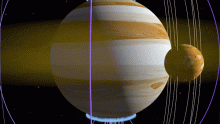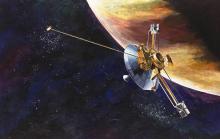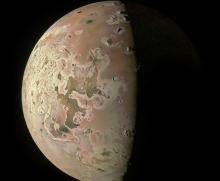Listen to today's episode of StarDate on the web the same day it airs in high-quality streaming audio without any extra ads or announcements. Choose a $8 one-month pass, or listen every day for a year for just $30.
You are here
Jupiter at Opposition II
Clouds here on Earth often form arcs and spirals — patterns related to our planet’s rotation. The clouds on Jupiter are related to its rotation as well: Because Jupiter spins so fast, the clouds are stretched into bands that encircle the entire planet.
The bands are different colors, which means their clouds are made of different materials and hover at different altitudes. The highest clouds are white, and are made of ammonia. Clouds in the next layer contain ammonia mixed with other compounds, so they look brown or orange. The lower layers contain water vapor and water ice, so they look bluer.
The clouds form alternating light and dark bands. The clouds in the lighter bands are pushed high into the atmosphere by rising bubbles of warm gas. The darker bands consist of cooler material that’s dropping back down into the atmosphere.
Each band has its own weather, which draws much of its energy not from the Sun, as is the case on Earth, but from deep within Jupiter itself. As gravity squeezes the planet, it produces heat that wells up through the atmosphere, then escapes into space. Before it escapes, though, it helps drive giant thunderstorms, and hurricanes that can be bigger than Earth — giant weather for a giant planet.
Jupiter looks like a brilliant star. It’s low in the east at nightfall, climbs high across the south around midnight, and sets around sunrise. More about Jupiter tomorrow.
Script by Damond Benningfield






